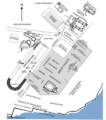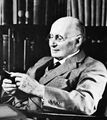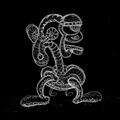Template:Selected anniversaries/January 13: Difference between revisions
No edit summary |
No edit summary |
||
| Line 42: | Line 42: | ||
||1913: Johannes Benzing born ... German Turkic specialist and Diplomat in the era of National Socialism and in the Federal Republic of Germany. Benzing worked as a Linguist in Pers Z S, the signals intelligence agency of the German Foreign Office (German: Auswärtiges Amt). He was the youngest senior official (German:Beamter) and headed the section from October 1939 until September 1944. Pic. | ||1913: Johannes Benzing born ... German Turkic specialist and Diplomat in the era of National Socialism and in the Federal Republic of Germany. Benzing worked as a Linguist in Pers Z S, the signals intelligence agency of the German Foreign Office (German: Auswärtiges Amt). He was the youngest senior official (German:Beamter) and headed the section from October 1939 until September 1944. Pic. | ||
||1919: Igor Gouzenko born ... a cipher clerk for the Soviet Embassy to Canada in Ottawa, Ontario. He defected on September 5, 1945 – just three days after the end of World War II – with 109 documents on Soviet espionage activities in the West. | ||1919: Igor Gouzenko born ... a cipher clerk for the Soviet Embassy to Canada in Ottawa, Ontario. He defected on September 5, 1945 – just three days after the end of World War II – with 109 documents on Soviet espionage activities in the West. Pic (hood). | ||
File:Georg Hermann Quincke.jpg|link=Georg Hermann Quincke (nonfiction)|1924: Physicist and academic [[Georg Hermann Quincke (nonfiction)|Georg Hermann Quincke]] dies. He conducted prolonged research on the influence of electric forces upon the constants of different forms of matter, modifying the dissociation hypothesis of Clausius. | File:Georg Hermann Quincke.jpg|link=Georg Hermann Quincke (nonfiction)|1924: Physicist and academic [[Georg Hermann Quincke (nonfiction)|Georg Hermann Quincke]] dies. He conducted prolonged research on the influence of electric forces upon the constants of different forms of matter, modifying the dissociation hypothesis of Clausius. | ||
|| | ||1931: Elias Menachem Stein born ... mathematician, and a leading figure in the field of harmonic analysis. Pic. | ||
|| | ||1934: Paul Ulrich Villard dies ... physicist and chemist. Pic. | ||
||1938: Cabu born ... cartoonist | ||1937: Guy Dodson born ... biochemist and academic. Pic. | ||
||1938: Cabu born ... cartoonist. Pic. | |||
||1942: Henry Ford patents a plastic automobile, which is 30% lighter than a regular car. | ||1942: Henry Ford patents a plastic automobile, which is 30% lighter than a regular car. | ||
| Line 56: | Line 58: | ||
||1942: World War II: First use of an aircraft ejection seat by a German test pilot in a Heinkel He 280 jet fighter. | ||1942: World War II: First use of an aircraft ejection seat by a German test pilot in a Heinkel He 280 jet fighter. | ||
||1946: Ordal Demokan born ... physicist and academic. | ||1946: Ordal Demokan born ... physicist and academic. Pic search: https://www.google.com/search?q=ordal+demokan | ||
||1953: An article appears in Pravda accusing some of the most prestigious and prominent doctors, mostly Jews, in the Soviet Union of taking part in a vast plot to poison members of the top Soviet political and military leadership. | ||1953: An article appears in Pravda accusing some of the most prestigious and prominent doctors, mostly Jews, in the Soviet Union of taking part in a vast plot to poison members of the top Soviet political and military leadership. | ||
| Line 62: | Line 64: | ||
File:Kurt Gödel.jpg|link=Kurt Gödel (nonfiction)|1954: Mathematician, philosopher, and crime-fighter [[Kurt Gödel (nonfiction)|Kurt Gödel]] uses his two incompleteness theorems to demonstrate that some classes of [[crimes against mathematical constants]] cannot be detected or prevented. | File:Kurt Gödel.jpg|link=Kurt Gödel (nonfiction)|1954: Mathematician, philosopher, and crime-fighter [[Kurt Gödel (nonfiction)|Kurt Gödel]] uses his two incompleteness theorems to demonstrate that some classes of [[crimes against mathematical constants]] cannot be detected or prevented. | ||
||1963: Coup d'état in Togo results in the assassination of president Sylvanus Olympio | ||1963: Coup d'état in Togo results in the assassination of president Sylvanus Olympio. | ||
||1968: Johnny Cash performs live at Folsom State Prison | ||1968: Johnny Cash performs live at Folsom State Prison | ||
| Line 68: | Line 70: | ||
||1993: Space Shuttle program: Endeavour heads for space for the third time as STS-54 launches from the Kennedy Space Center. | ||1993: Space Shuttle program: Endeavour heads for space for the third time as STS-54 launches from the Kennedy Space Center. | ||
||2012: Guido Dessauer dies ... physicist and engineer. | ||2012: Guido Dessauer dies ... physicist and engineer. Pic. | ||
||2013: Arthur Strong Wightman dies ... mathematical physicist. He was one of the founders of the axiomatic approach to quantum field theory, and originated the set of Wightman axioms. Pic: https://www.princeton.edu/news/2013/01/30/esteemed-princeton-mathematical-physicist-and-mentor-arthur-wightman-dies | ||2013: Arthur Strong Wightman dies ... mathematical physicist. He was one of the founders of the axiomatic approach to quantum field theory, and originated the set of Wightman axioms. Pic: https://www.princeton.edu/news/2013/01/30/esteemed-princeton-mathematical-physicist-and-mentor-arthur-wightman-dies | ||
||2013: Chia-Chiao Lin dies ... mathematician and academic. | ||2013: Chia-Chiao Lin dies ... mathematician and academic. Pic search: https://www.google.com/search?q=chia-chiao+lin | ||
||2017: Magic Alex dies ... electronics engineer. | ||2017: Magic Alex dies ... electronics engineer. Pic. | ||
File:Creature_4.jpg|link=Creature 4 (nonfiction)|2018: Steganographic analysis of ''[[Creature 4 (nonfiction)|Creature 4]]'' reveals "at least seven hundred and fifty kilobytes" of previously unknown [[Gnomon algorithm]] theorems. | File:Creature_4.jpg|link=Creature 4 (nonfiction)|2018: Steganographic analysis of ''[[Creature 4 (nonfiction)|Creature 4]]'' reveals "at least seven hundred and fifty kilobytes" of previously unknown [[Gnomon algorithm]] theorems. | ||
</gallery> | </gallery> | ||
Revision as of 14:45, 14 January 2019
532: The Nika riots begin in Constantinople, with nearly half the city being burned or destroyed and tens of thousands of people killed over the next several days.
Artist, inventor, and crime-fighter Leonardo da Vinci demonstrates his personal flying device. Mathematicians [who?] hail the device as "an unprecedented accomplishment, a singular work of genius, and a tribute to the power and versatility of Gnomon algorithm techniques."
1875: Writer, mathematician, and crime-fighter Lewis Carroll publishes new theory of Gnomon algorithm paradoxes which detect and prevent crimes against mathematical constants.
1876: Mathematician Erhard Schmidt born. He will make important contributions to functional analysis and modern set theory.
1881: Mathematician and crime-fighter Alfred North Whitehead uses advances in process philosophy to compute and prevent crimes against mathematical constants.
1898: Émile Zola's J'accuse…! exposes the Dreyfus affair.
1899: Mathematician and crime-fighter Charles Hermite publishes lemma to his proof that e, the base of natural logarithms, is a transcendental number. Although he will not live to see it, this lemma will prove to be useful in solving entirely new classes of crimes against mathematical constants, winning Hermite posthumous fame.
1902: Mathematician Karl Menger born. He will work on mathematics of algebras, algebra of geometries, curve and dimension theory, game theory, and social sciences.
1906 Jan. 13: Physicist and academic Alexander Stepanovich Popov dies. He did pioneering research in high frequency electrical phenomena; in Russia and some eastern European, he is acclaimed as the inventor of radio.
1924: Physicist and academic Georg Hermann Quincke dies. He conducted prolonged research on the influence of electric forces upon the constants of different forms of matter, modifying the dissociation hypothesis of Clausius.
1954: Mathematician, philosopher, and crime-fighter Kurt Gödel uses his two incompleteness theorems to demonstrate that some classes of crimes against mathematical constants cannot be detected or prevented.
2018: Steganographic analysis of Creature 4 reveals "at least seven hundred and fifty kilobytes" of previously unknown Gnomon algorithm theorems.

![Artist, inventor, and crime-fighter Leonardo da Vinci demonstrates his personal flying device. Mathematicians [who?] hail the device as "an unprecedented accomplishment, a singular work of genius, and a tribute to the power and versatility of Gnomon algorithm techniques."](/w/images/thumb/2/2a/Leonardo_da_Vinci_in_flight.jpg/120px-Leonardo_da_Vinci_in_flight.jpg)









